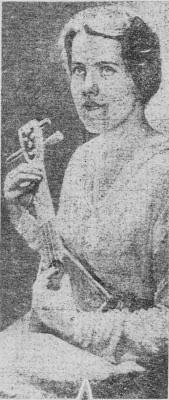Harriet Works Corley
(b. Fitchburg, Massachusetts, 24 May 1889; d. New York, New York, 9 February 1954)
 |
| newlywed Mrs. Donald Corley |
Harriet Evelyn Works was the oldest of four children of
Frank Hamilton Works (1861-1905), a contractor and bridge builder, and Bessie
Elder Morris (1864-1926), who were married in Biddeford, Maine, on 10 August
1888. Harriet’s birth in Fitchburg,
Massachusetts, was soon followed by that of two sisters, and, in 1897, a brother.
By 1900, Bessie Works was institutionalized at the Worcester State Hospital, a
lunatic asylum, where she remained for the rest of her life. Harriet and her
siblings grew up in Fitchburg, though they were split up after the death of
their father from Bright’s Disease in August 1905.
Harriet gravitated to New York, and began contributing to
magazines. In November 1912 and January 1914 she contributed poems to Harper’s Magazine. By 1916 she was known as a writer of children’s
stories, and at a dinner party in New York on Thursday, 20 July 1916, she met
the architect, artist and writer, Donald Corley (1886-1955). The next day he
proposed to her and she accepted, and two days later, on Sunday, 23 July 1916,
they were married. Their hasty courtship
and marriage served as fodder for various newspapers.
The marriage apparently did not last long. By June 1917,
Donald Corley’s draft registration lists him as unemployed, with a wife and one
child, Sheila Brooke Corley (1917-1985). By
the time of the 1920 Census, Donald was living in a boarding house, his marital
status given as single. Harriet continued writing, now using the byline “Harriet
Works Corley”. The first appearance I have
found dates from November 1918, on an article for the New York newspaper The Evening Telegram. Her writings would appear in various magazines
throughout the 1920s and 1930s, including stories in Flynn’s Weekly Detective Fiction (and in its retitled form as Detective Fiction Weekly), Mystery (published by Tower Magazines
and sold only in Woolworth stores), and Street
and Smith’s Detective Story Magazine; and nonfiction in Photoplay, Everybody’s Magazine, and Good
Housekeeping. Her final story that I
have traced appeared in Double Detective
in May 1940.
Her two novels were both bylined “H. W. Corley”, and the
first, For Love or Money (New York: Grosset
& Dunlap, 1932), concerns an impetuous marriage—here a young woman is asked
by a lawyer to marry one of his rich clients, and to give the marriage one year
before deciding whether it should be permanent. For Love or Money was published in October 1932; her second and final
novel, Spotlight (New York: Grosset
& Dunlap, 1933) appeared only six months later, in April. In the late
1930s, she was working for the Federal Writers’ Project as a district
supervisor in Greensboro, North Carolina.
*updated 10 September 2021

No comments:
Post a Comment